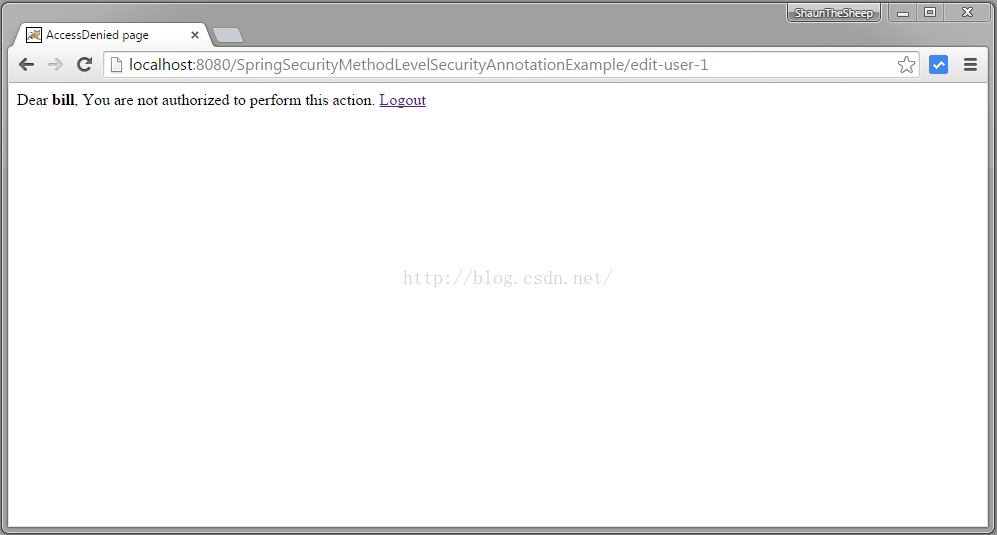【相关已翻译的本系列其他文章,点击分类里面的spring security 4】
上一篇:Spring Security 4 整合Hibernate 实现持久化登录验证(带源码)
本文探讨Spring Security 4 基于@PreAuthorize, @PostAuthorize, @Secured和 Spring EL表达式的方法级的安全。
想要开启Spring方法级安全,你需要在已经添加了@Configuration注解的类上再添加@EnableGlobalMethodSecurity注解:
- package com.websystique.springsecurity.configuration;
- import org.springframework.beans.factory.annotation.Autowired;
- import org.springframework.context.annotation.Configuration;
- import org.springframework.security.config.annotation.authentication.builders.AuthenticationManagerBuilder;
- import org.springframework.security.config.annotation.method.configuration.EnableGlobalMethodSecurity;
- import org.springframework.security.config.annotation.web.builders.HttpSecurity;
- import org.springframework.security.config.annotation.web.configuration.EnableWebSecurity;
- import org.springframework.security.config.annotation.web.configuration.WebSecurityConfigurerAdapter;
- @Configuration
- @EnableWebSecurity
- @EnableGlobalMethodSecurity(prePostEnabled = true)
- public class SecurityConfiguration extends WebSecurityConfigurerAdapter {
- @Autowired
- public void configureGlobalSecurity(AuthenticationManagerBuilder auth) throws Exception {
- auth.inMemoryAuthentication().withUser("bill").password("abc123").roles("USER");
- auth.inMemoryAuthentication().withUser("admin").password("root123").roles("ADMIN");
- auth.inMemoryAuthentication().withUser("dba").password("root123").roles("ADMIN","DBA");
- }
- @Override
- protected void configure(HttpSecurity http) throws Exception {
- http.authorizeRequests()
- .antMatchers("/", "/home").access("hasRole('USER') or hasRole('ADMIN') or hasRole('DBA')")
- .and().formLogin().loginPage("/login")
- .usernameParameter("ssoId").passwordParameter("password")
- .and().exceptionHandling().accessDeniedPage("/Access_Denied");
- }
- }
Security 全局方法安全,等价的XML配置如下:
- <beans:beans xmlns="http://www.springframework.org/schema/security"
- xmlns:beans="http://www.springframework.org/schema/beans"
- xmlns:xsi="http://www.w3.org/2001/XMLSchema-instance"
- xsi:schemaLocation="http://www.springframework.org/schema/beans http://www.springframework.org/schema/beans/spring-beans-4.1.xsd
- http://www.springframework.org/schema/security http://www.springframework.org/schema/security/spring-security-4.0.xsd">
- <http auto-config="true" >
- <intercept-url pattern="/" access="hasRole('USER') or hasRole('ADMIN') and hasRole('DBA')" />
- <intercept-url pattern="/home" access="hasRole('USER') or hasRole('ADMIN') and hasRole('DBA')" />
- <form-login login-page="/login"
- username-parameter="ssoId"
- password-parameter="password"
- authentication-failure-url="/Access_Denied" />
- </http>
- <global-method-security pre-post-annotations="enabled"/>
- <authentication-manager >
- <authentication-provider>
- <user-service>
- <user name="bill" password="abc123" authorities="ROLE_USER" />
- <user name="admin" password="root123" authorities="ROLE_ADMIN" />
- <user name="dba" password="root123" authorities="ROLE_ADMIN,ROLE_DBA" />
- </user-service>
- </authentication-provider>
- </authentication-manager>
- </beans:beans>
注意: @EnableGlobalMethodSecurity 可以配置多个参数:
- prePostEnabled :决定Spring Security的前注解是否可用 [@PreAuthorize,@PostAuthorize,..]
- secureEnabled : 决定是否Spring Security的保障注解 [@Secured] 是否可用
- jsr250Enabled :决定 JSR-250 annotations 注解[@RolesAllowed..] 是否可用.
You can enable more than one type of annotation in the same application, but only one type should be used for any interface or class as the behavior will not be well-defined otherwise. If two annotations are found which apply to a particular method, then only one of them will be applied.
在同一个应用程序中,可以启用多个类型的注解,但是只应该设置一个注解对于行为类的接口或者类。如果将2个注解同事应用于某一特定方法,则只有其中一个将被应用。
我们将研究上面提到的前两个注解。
@Secured
此注释是用来定义业务方法的安全配置属性的列表。您可以在需要安全[角色/权限等]的方法上指定 @Secured,并且只有那些角色/权限的用户才可以调用该方法。如果有人不具备要求的角色/权限但试图调用此方法,将会抛出AccessDenied 异常。
@Secured 源于 Spring之前版本.它有一个局限就是不支持Spring EL表达式。可以看看下面的例子:
- package com.websystique.springsecurity.service;
- import org.springframework.security.access.annotation.Secured;
- public interface UserService {
- List<User> findAllUsers();
- @Secured("ROLE_ADMIN")
- void updateUser(User user);
- @Secured({ "ROLE_DBA", "ROLE_ADMIN" })
- void deleteUser();
- }
在上面的例子中,updateUser 方法只能被拥有ADMIN 权限的用户调用。deleteUser 方法只能够被拥有DBA 或者ADMIN 权限的用户调用。
如果有不具有声明的权限的用户调用此方法,将抛出AccessDenied异常。
如果你想指定AND(和)这个条件,我的意思说deleteUser 方法只能被同时拥有ADMIN & DBA 。但是仅仅通过使用 @Secured注解是无法实现的。
但是你可以使用Spring的新的注解@PreAuthorize/@PostAuthorize(支持Spring EL),使得实现上面的功能成为可能,而且无限制。
@PreAuthorize / @PostAuthorize
Spring的 @PreAuthorize/@PostAuthorize 注解更适合方法级的安全,也支持Spring
表达式语言,提供了基于表达式的访问控制。
@PreAuthorize 注解适合进入方法前的权限验证, @PreAuthorize可以将登录用户的roles/permissions参数传到方法中。
@PostAuthorize 注解使用并不多,在方法执行后再进行权限验证。
所以它适合验证带有返回值的权限。Spring EL 提供 返回对象能够在表达式语言中获取返回的对象returnObject。
请参考 Common Built-In Expressions 获取支持的表达式.
现在言归正常,使用@PreAuthorize / @PostAuthorize注解
- package com.websystique.springsecurity.service;
- import org.springframework.security.access.prepost.PostAuthorize;
- import org.springframework.security.access.prepost.PreAuthorize;
- import com.websystique.springsecurity.model.User;
- public interface UserService {
- List<User> findAllUsers();
- @PostAuthorize ("returnObject.type == authentication.name")
- User findById(int id);
- @PreAuthorize("hasRole('ADMIN')")
- void updateUser(User user);
- @PreAuthorize("hasRole('ADMIN') AND hasRole('DBA')")
- void deleteUser(int id);
- }
由于 @PreAuthorize可以使用Spring 表达式语言, 使用EL表达式可以轻易的表示任意条件. deleteUser方法 可以被拥有ADMIN & DBA角色的用户调用 .
另外,我们增加了带有@PostAuthorize注解的findById()方法。通过@PostAuthorize注解 method(User
object)的返回值在Spring表达式语言中可以通过returnObject 来使用。在例子中我们确保登录用户只能获取他自己的用户对象。
上面就是@Secured, @PreAuthorize, @PostAuthorize 和EL的使用
下面提到的service实现, User 模型& 控制器
- package com.websystique.springsecurity.service;
- import java.util.ArrayList;
- import java.util.List;
- import org.springframework.stereotype.Service;
- import org.springframework.transaction.annotation.Transactional;
- import com.websystique.springsecurity.model.User;
- @Service("userService")
- @Transactional
- public class UserServiceImpl implements UserService{
- static List<User> users = new ArrayList<User>();
- static{
- users = populateUser();
- }
- public List<User> findAllUsers(){
- return users;
- }
- public User findById(int id){
- for(User u : users){
- if(u.getId()==id){
- return u;
- }
- }
- return null;
- }
- public void updateUser(User user) {
- System.out.println("Only an Admin can Update a User");
- User u = findById(user.getId());
- users.remove(u);
- u.setFirstName(user.getFirstName());
- u.setLastName(user.getLastName());
- u.setType(user.getType());
- users.add(u);
- }
- public void deleteUser(int id){
- User u = findById(id);
- users.remove(u);
- }
- private static List<User> populateUser(){
- List<User> users = new ArrayList<User>();
- users.add(new User(1,"Sam","Disilva","admin"));
- users.add(new User(2,"Kevin","Brayn","admin"));
- users.add(new User(3,"Nina","Conor","dba"));
- users.add(new User(4,"Tito","Menz","dba"));
- return users;
- }
- }
- public class User {
- private int id;
- private String firstName;
- private String lastName;
- private String type;
- //getters/setters
- }
- package com.websystique.springsecurity.controller;
- import java.util.List;
- import javax.servlet.http.HttpServletRequest;
- import javax.servlet.http.HttpServletResponse;
- import org.springframework.beans.factory.annotation.Autowired;
- import org.springframework.security.core.Authentication;
- import org.springframework.security.core.context.SecurityContextHolder;
- import org.springframework.security.core.userdetails.UserDetails;
- import org.springframework.security.web.authentication.logout.SecurityContextLogoutHandler;
- import org.springframework.stereotype.Controller;
- import org.springframework.ui.ModelMap;
- import org.springframework.web.bind.annotation.PathVariable;
- import org.springframework.web.bind.annotation.RequestMapping;
- import org.springframework.web.bind.annotation.RequestMethod;
- import com.websystique.springsecurity.model.User;
- import com.websystique.springsecurity.service.UserService;
- @Controller
- public class HelloWorldController {
- @Autowired
- UserService service;
- @RequestMapping(value = { "/", "/list" }, method = RequestMethod.GET)
- public String listAllUsers(ModelMap model) {
- List<User> users = service.findAllUsers();
- model.addAttribute("users", users);
- return "allusers";
- }
- @RequestMapping(value = { "/edit-user-{id}" }, method = RequestMethod.GET)
- public String editUser(@PathVariable int id, ModelMap model) {
- User user = service.findById(id);
- model.addAttribute("user", user);
- model.addAttribute("edit", true);
- return "registration";
- }
- @RequestMapping(value = { "/edit-user-{id}" }, method = RequestMethod.POST)
- public String updateUser(User user, ModelMap model, @PathVariable int id) {
- service.updateUser(user);
- model.addAttribute("success", "User " + user.getFirstName() + " updated successfully");
- return "success";
- }
- @RequestMapping(value = { "/delete-user-{id}" }, method = RequestMethod.GET)
- public String deleteUser(@PathVariable int id) {
- service.deleteUser(id);
- return "redirect:/list";
- }
- @RequestMapping(value = "/Access_Denied", method = RequestMethod.GET)
- public String accessDeniedPage(ModelMap model) {
- model.addAttribute("user", getPrincipal());
- return "accessDenied";
- }
- @RequestMapping(value = "/login", method = RequestMethod.GET)
- public String loginPage() {
- return "login";
- }
- @RequestMapping(value="/logout", method = RequestMethod.GET)
- public String logoutPage (HttpServletRequest request, HttpServletResponse response) {
- Authentication auth = SecurityContextHolder.getContext().getAuthentication();
- if (auth != null){
- new SecurityContextLogoutHandler().logout(request, response, auth);
- }
- return "redirect:/login?logout";
- }
- private String getPrincipal(){
- String userName = null;
- Object principal = SecurityContextHolder.getContext().getAuthentication().getPrincipal();
- if (principal instanceof UserDetails) {
- userName = ((UserDetails)principal).getUsername();
- } else {
- userName = principal.toString();
- }
- return userName;
- }
- }
项目代码将在文章最后提供。
不部署 & 运行
下载本文末尾的项目代码 在一个 Servlet 3.0 容器中发布本应用. 在这里我使用的是tomcat
打开浏览器访问 http://localhost:8080/SpringSecurityMethodLevelSecurityAnnotationExample/, 将被转到登录界面. 填入 USER 权限的证书。
尝试删除用户,就会转到 访问拒绝页面因为USER 角色没有删除权限。
用ADMIN角色的账户登录
回到用户列表界面
编辑一个带有dba角色的账户
访问拒绝的原因是带有@PostAuthorize 注解的findById 方法,带有Spring EL表单式限制只有dba角色的用户才可以调用。
只能够删除dba角色的账户,删除其他账户都会出现访问拒绝页面。
退出然后用拥有DBA角色的账户登录 [dba,root123],点击第一个用户的删除链接。这个用户将被成功删除掉。
项目源码下载地址:http://websystique.com/?smd_process_download=1&download_id=1475








